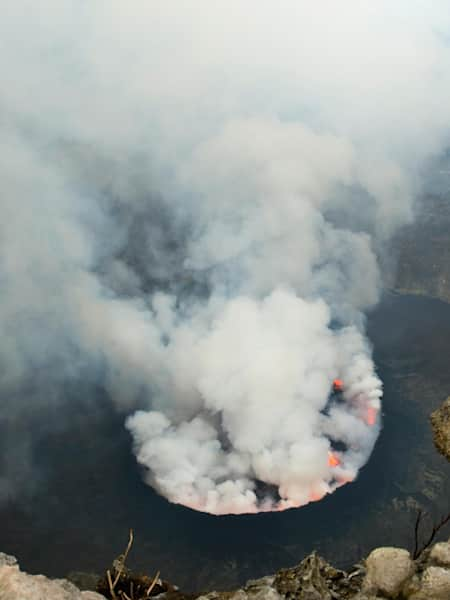Remember that feeling when you stare into a fire and can't look away. Imagine that, now multiply by 10. Volcanoes may be deadly, destructive and immensely powerful, but they're also awesome and mesmerising. Best of all, a lot of the world's volcanoes are relatively easy to explore.
“Volcanic activity is maybe the most fascinating force of the planet,” says volcanologist and volcano tour guide Tom Pfeiffer. “Every volcano has a distinct character and witnessing an eruption – from a safe point, of course – is an experience that compares to no other.”
The only question? Where to go...
More: The 8 wildest toilets worth holding out for
1. Best for eruptions
Name: Yasur
Location: Tanna Island, Vanuatu
Activity: High. Constant eruptions have been occurring since records began.
Danger: Medium. The crater is constantly monitored and tourist operators will only go in when safe.
Access: Challenging. It takes a three-day trip to reach the active crater.
Vanuatu has six volcanoes that have erupted this century, but Yasur is the most spectacular, splurging out lava several times an hour. It is famous for spectacular eruptions that spit molten rock up to 350m high and a well-monitored crater that allows visitors to get right up close.
2. Best for the geysers
Name: Landmannalaugar
Location: Fjallabak Nature Reserve, Iceland
Activity: Nil. Last erupted around 1477.
Danger: Low. No recent eruptive activity, but Iceland’s volcanic regions are active and are regularly monitored
Access: Easy. Several roads run to the area, but 4x4 vehicles are advised.
One of the best places to see what’s left behind after an eruption, with colourful mountains, a rhyolite lava field, crater lakes, powerful geysers and hot and cold springs.
3. Best for hot stinking gases
Name: White Island
Location: North Island, New Zealand
Activity: Medium. The most recent explosive eruption occurred in 2013, but unrest continues.
Danger: Medium. Toxic gases and sulphurous fumes make this a hazardous environment and visitors are advised to wear gas masks.
Access: Easy. Boats from the mainland take six hours to reach the island.
Sitting 48km off the coast of the Bay of Plenty, this unique smoking island, measuring just 2km in diameter, lets visitors walk straight into an active crater. Inside, there are bubbling mud pits, hot volcanic streams, a lake of steaming acid and fumaroles that spit out acidic white gas.
4. Best for bubbling lava lake
Name: Kilauea
Location: Big Island, Hawaii, USA
Activity: High. Live activity is currently creating a giant new lava lake.
Danger: Low. Despite the high activity, the area is well monitored and viewing points are kept distant.
Access: Easy. Paved roads now lead to the best look-out.
Boat tours used to give dramatic access to lava meeting the ocean (as above) until that flow was cut off in 2014. Now the action is at the Halemaʻumaʻu Overlook crater, where lava recently overflowed to create a bubbling lava lake.
5. Best for the adventure
Name: Erta Ale
Location: Afar Depression, Ethiopia
Activity: High. Constant eruption seeps lava into a lava lake.
Danger: High. The volcano is relatively stable, but the region is not. The Afar people are not always welcoming to visitors.
Access: Challenging. It takes a two-day 4x4 drive then a hike to reach with few operators offering organised tours.
In the crater of this shallow volcano sits the world’s oldest lava lake, with lava now just 5-10m below the rim. To reach, visitors must cross the inhospitable terrain of the Danakil depression, which includes surreal colour landscapes, salt flats, geysers, hot springs and certain death if you get lost.
6. Best for the crater’s edge
Name: Nyiragongo
Location: Virunga National Park, Democratic Republic of the Congo
Activity: High. The volcano constantly feeds into a bubbling lava lake.
Danger: Medium. The area was closed for two years, but re-opened in 2014. The volcano itself is relatively stable.
Access: Challenging. Over 500km of off-road driving and a hike to 1,400m altitude is required to reach the crater’s edge.
Accessed through a jungle filled with chimpanzees, monkeys, and bushbuck, this desolate 1.2km diameter summit rim offers the chance to stare directly into a mosaic of extremely fluid lava. Hot gases explode beneath the crusted surface to create spectacular red-hot fountains.
7. Best for easy access
Name: Stromboli
Location: Aeolian Islands, Italy
Activity: High. After a winter of relative quiet, there are now up to four explosions per hour in the crater.
Danger: Low. The area is well monitored and active sites can only be visited with experienced guides.
Access: Easy. The island is accessed by boat on organised tours.
The volcano that gave its name to its specific type of explosive eruptions, Stromboli is constantly active and offers spectacular natural fireworks. When activity levels allow, visitors can reach a natural viewpoint 918m up to look right into the mountain at the spitting lava.








